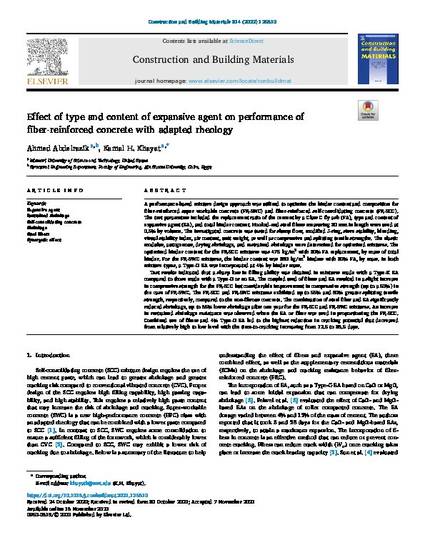
A performance-based mixture design approach was utilized to optimize the binder content and composition for fiber-reinforced super workable concrete (FR-SWC) and fiber-reinforced self-consolidating concrete (FR-SCC). The test parameters included the replacement ratio of the cement by a Class C fly ash (FA), type and content of expansive agent (EA), and total binder content. Hooked-end steel fibers measuring 30 mm in length were used at 0.5% by volume. The investigated concrete was tested for slump flow, modified J-ring, sieve stability, bleeding, visual stability index, air content, unit weight, as well as compressive and splitting tensile strengths. The elastic modulus, autogenous, drying shrinkage, and restrained shrinkage were determined for optimized mixtures. The optimized binder content for the FR-SCC mixtures was 475 kg/m3 with 30% FA replacement, by mass of total binder. For the FR-SWC mixtures, the binder content was 380 kg/m3 binders with 30% FA, by mass. In both mixture types, a Type-G EA was incorporated at 4% by binder mass. Test results indicated that a sharp loss in filling ability was obtained in mixtures made with a Type-K EA compared to those made with a Type-G or no EA. The coupled used of fibers and EA resulted in a slight increase in compressive strength for the FR-SCC but considerable improvement in compressive strength (up to a 50%) in the case of FR-SWC. The FR-SCC and FR-SWC mixtures exhibited up to 55% and 80% greater splitting tensile strength, respectively, compared to the non-fibrous concrete. The combination of steel fiber and EA significantly reduced shrinkage, up to 65% lower shrinkage after one year for the FR-SCC and FR-SWC mixtures. An increase in restrained shrinkage resistance was observed when the EA or fiber was used in proportioning the FR-SCC. Combined use of fibers and 4% Type-G EA led to the highest reduction in cracking potential that decreased from relatively high to low level with the time-to-cracking increasing from 12.5 to 36.5 days.
- Expansive agent,
- Restrained shrinkage,
- Self-consolidating concrete,
- Shrinkage,
- Steel fibers,
- Synergetic effect
Available at: http://works.bepress.com/kamal-khayat/175/

Missouri Department of Transportation, Grant TR2015-05